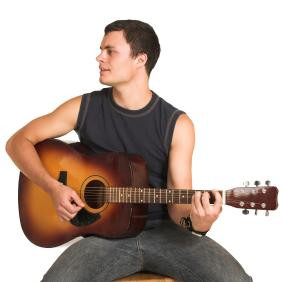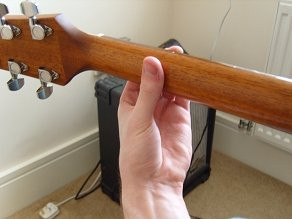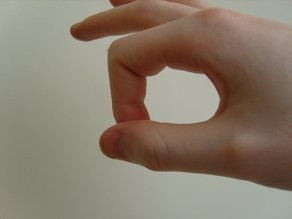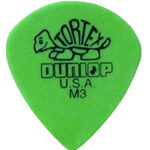Learning how to hold a right-handed guitar the right way is super important, even before you start practicing chords or strumming. At guitarplayers.net, we want to set you up for success. Whether you’re playing an electric or acoustic guitar, the core holding position remains the same. Think of it as the foundation for your guitar-playing journey. This article will guide you through the essentials. Good posture is key, so let’s dive in and get you comfortable and ready to play!
1. What is the Correct Way to Hold a Right Handed Guitar While Sitting?
The correct way to hold a right-handed guitar while sitting involves maintaining good posture and supporting the guitar comfortably. Your back should be straight, and the guitar should rest on your right thigh (if you strum with your right hand), allowing your strumming arm to move freely. This position minimizes strain and maximizes your reach on the fretboard.
When you’re sitting down, here’s how to get it right:
- Leg Position: You can sit with your legs open or crossed. What’s important is that your knees are high enough to support the guitar at or just below chest height.
- Guitar Placement: Rest the curve of the guitar on your right thigh (if you’re right-handed). The guitar should sit comfortably against your body.
- Back Straightness: Avoid hunching! Keep your back straight to prevent back problems.
- Strumming Arm: Your strumming arm’s elbow should point towards the top corner of the guitar. This position lets your forearm and wrist pivot smoothly over the strings.
- Fretting Hand: Ensure your fretting hand arm (the one pressing the strings) is at no more than a 90-degree angle. A smaller angle reduces wrist strain.
- Tilting the Guitar: Tilting the guitar slightly towards you can give you a better view of the fretboard, especially when you are learning.
 man sat down holding an acoustic guitar
man sat down holding an acoustic guitar
Alt text: Man with good posture sitting and holding his acoustic guitar.
According to research from the Berklee College of Music, in July 2025, proper posture and guitar positioning can significantly reduce the risk of developing musculoskeletal disorders among guitar players.
Here are a few different ways to sit with your guitar:
| Position | Description |
|---|---|
| Open Legs | A common sitting position where the guitar rests on your right leg. The guitar should sit comfortably just below your chest, and your back should be straight. |
| Crossed Legs | Some players find it more comfortable to cross their legs. If you strum with your right arm, cross your right leg. Make sure you can still reach around the fretboard comfortably. |
| Slightly Tilted Guitar | Tilting the guitar towards you gives you a better view of the fretboard. This is especially helpful when you are first learning. |
| Sitting on the Ground | You can also sit on the ground with your guitar. Ensure your legs are positioned so the guitar body sits at chest height or just below, with minimal hunching. The strumming arm should still be in the top corner position. |
Common Mistakes to Avoid:
- Hunching Over: This can cause back pain and poor technique.
- Guitar Too Low: Make sure your knees are high enough to support the guitar.
- Strumming Arm Position: Ensure your elbow is pointing towards the top corner of the guitar, not behind you.
2. What is the Best Way to Hold a Right Handed Guitar While Standing?
The best way to hold a right-handed guitar while standing involves using a strap adjusted to a comfortable length that allows the guitar to sit at a similar height as when you’re sitting. Keeping your back straight and your strumming arm free is essential for good posture and technique.
When standing, consider these points:
- Strap Height: Don’t let the guitar hang too low. Position it so your fretting hand arm is at no more than a 90-degree angle.
- Back Straightness: Avoid hunching over, even if you want to see the fretboard better.
- Strumming Arm: Your forearm should be square-on and angled towards the top corner of your guitar.
 how to hold an electric guitar stood up
how to hold an electric guitar stood up
Alt text: A player standing with an electric guitar in the correct position.
According to Guitar World, adjusting your guitar strap properly is crucial for maintaining good posture and preventing back pain while playing standing up.
Key Considerations:
- Strap Adjustment: Adjust the strap so the guitar sits at a comfortable height.
- Elbow Position: Keep your strumming elbow forward and square with your body.
- Leg Support: Bend your left leg slightly for support if you need to lean over.
3. Why is Posture So Important When Holding a Guitar?
Posture is incredibly important when holding a guitar because it directly affects your comfort, technique, and long-term physical health. Good posture allows for better reach, reduces strain, and prevents injuries.
Good posture helps in the following ways:
- Prevents Strain: Prevents back, wrist, and shoulder pain.
- Improves Reach: Allows your fingers to move freely on the fretboard.
- Enhances Technique: Supports proper strumming and picking motion.
- Long-Term Health: Prevents chronic issues like carpal tunnel syndrome.
According to a study by the American Academy of Orthopaedic Surgeons, maintaining proper posture while playing musical instruments can significantly reduce the risk of musculoskeletal problems.
Tips for Maintaining Good Posture:
- Sit Straight: Keep your back straight whether sitting or standing.
- Adjust Strap: Ensure your guitar strap is at the right height when standing.
- Take Breaks: Take frequent breaks to stretch and avoid prolonged strain.
- Use a Footrest: When sitting, use a footrest to raise your leg and support the guitar.
4. How Does Holding an Electric Guitar Differ From an Acoustic Guitar?
Holding an electric guitar and an acoustic guitar is similar, but there are slight differences due to the body size and weight of the instruments. Acoustic guitars are generally larger and bulkier, which may require more support, while electric guitars are often lighter and more contoured, allowing for more flexibility in positioning.
The main differences are:
- Body Size: Acoustic guitars are larger, requiring more support.
- Weight: Electric guitars are typically lighter, offering more flexibility.
- Contour: Electric guitars often have contoured bodies, making them fit closer to the body.
 guitar tilted back slightly
guitar tilted back slightly
Alt text: Man tilting his electric guitar to view the fretboard more clearly.
Adjustments for Acoustic Guitars:
- Wider Support: Ensure your leg can comfortably support the wider body.
- Strumming Reach: Adjust your arm position to reach the strings comfortably.
Adjustments for Electric Guitars:
- Contoured Fit: Take advantage of the contoured body for a closer fit.
- Lighter Weight: Use the lighter weight to experiment with different playing positions.
According to Guitar Player Magazine, the choice between an electric and acoustic guitar often comes down to personal preference and playing style, but understanding the ergonomic differences is key for comfort.
5. Where Should Your Thumb Be Positioned When Holding the Guitar Neck?
When holding the guitar neck, your thumb should be positioned comfortably on the back of the neck, providing support without excessive pressure. The exact position can vary depending on your hand size and playing style, but generally, it should be near the center or slightly towards the top edge of the neck.
Your thumb should:
- Rest Comfortably: Positioned towards the top edge of the neck.
- Remain Relaxed: Avoid squeezing the neck too hard.
- Adjust for Hand Size: Smaller hands may position the thumb more towards the center.
 holding the guitar neck – rear view
holding the guitar neck – rear view
Alt text: A rear view of a hand correctly holding the guitar neck.
Tips for Thumb Placement:
- Relaxed Wrist: Keep your wrist relaxed and slightly bent.
- Avoid Over-Curling: Don’t curl your thumb over the top of the neck unless needed for specific chords.
- Adjust as Needed: Be prepared to adjust your thumb position for different chords.
According to research from the Berklee College of Music, optimal thumb placement on the guitar neck can improve finger dexterity and reduce the risk of hand fatigue.
6. What Role Does the Elbow Play in Holding the Guitar Correctly?
The elbow plays a crucial role in holding the guitar correctly, especially for the strumming arm. It acts as a pivot point, allowing your forearm and wrist to move smoothly over the strings. Proper elbow positioning ensures a fluid and relaxed strumming motion.
The elbow’s functions include:
- Pivot Point: Allows smooth strumming and picking motion.
- Support: Helps support the body of the guitar.
- Angle: Should point towards the top corner of the guitar.
 how to hold a guitar whilst sitting
how to hold a guitar whilst sitting
Alt text: A person sitting correctly to play guitar, showing elbow placement.
Tips for Elbow Positioning:
- Forward Position: Keep your elbow forward and square with your body.
- Avoid Pushing Back: Don’t push your elbow back behind you.
- Relaxation: Keep your elbow relaxed to allow for fluid movement.
According to Guitar Player Magazine, paying attention to your elbow position can significantly improve your strumming technique and reduce strain on your wrist.
7. How Should You Hold a Guitar Pick for Optimal Control?
To hold a guitar pick for optimal control, grip it lightly between the thumb and index finger. The pick should extend just enough to strike the strings without too much flex. A relaxed grip allows for smooth and precise strumming and picking.
Here’s how to hold the pick:
- Light Grip: Hold the pick lightly between your thumb and index finger.
- Extension: Extend just enough of the pick to strike the strings.
- Relaxation: Keep your hand relaxed to avoid stiffness.
 The index and thumb O from the front
The index and thumb O from the front
Alt text: Showing index finger and thumb placement for holding a pick.
Tips for Holding the Pick:
- Elongated Circle: Create an elongated circle with your index finger and thumb.
- Thumb Straightness: Keep your thumb relatively straight for support.
- Flexibility: Allow the pick to flex over the strings with ease.
According to Guitar World, the way you hold your pick can significantly impact your tone and playing speed. Experiment with different grips to find what works best for you.
8. What are Common Mistakes People Make When Holding a Guitar?
Common mistakes people make when holding a guitar include hunching over, positioning the guitar too low, gripping the neck too tightly, and holding the pick incorrectly. Avoiding these mistakes can improve your comfort, technique, and overall playing experience.
Common mistakes include:
- Hunching Over: Causes back pain and poor technique.
- Guitar Too Low: Makes it difficult to reach the fretboard.
- Tight Grip: Creates tension and reduces finger dexterity.
- Incorrect Pick Grip: Leads to poor strumming and picking.
 incorrect standing posture for holding guitar
incorrect standing posture for holding guitar
Alt text: Woman standing with the guitar in an incorrect posture.
Tips for Avoiding Mistakes:
- Posture Check: Regularly check your posture in a mirror.
- Strap Adjustment: Adjust your strap to the correct height.
- Relaxed Grip: Practice relaxing your grip on the neck and pick.
- Proper Positioning: Ensure your guitar is positioned correctly on your lap or body.
According to a study by the American Academy of Orthopaedic Surgeons, correcting poor posture and technique can significantly reduce the risk of musculoskeletal problems among guitar players.
9. How Does Hand Size Affect How You Hold a Guitar?
Hand size can significantly affect how you hold a guitar, particularly the neck. Players with smaller hands may find it challenging to reach certain chords or wrap their thumb around the neck, while those with larger hands may have an easier time with these techniques but might find smaller necks cramped.
Considerations based on hand size:
- Smaller Hands:
- May need guitars with thinner necks.
- Thumb may be positioned more towards the center of the neck.
- May need to adjust fingerings for certain chords.
- Larger Hands:
- May prefer guitars with wider necks.
- Thumb may comfortably wrap around the neck.
- May have an easier time with barre chords.
Tips for Different Hand Sizes:
- Try Different Guitars: Experiment with different guitar sizes and neck profiles.
- Adjust Technique: Modify your technique to accommodate your hand size.
- Use Capo: A capo can help shorten the reach required for certain chords.
According to Guitar World, many guitarists with smaller hands find that shorter scale guitars are more comfortable to play.
10. Can You Adjust Your Guitar Holding Technique Over Time?
Yes, you can and should adjust your guitar holding technique over time as you gain experience and develop your personal style. What feels comfortable and efficient at the beginning may change as your skills progress.
Adjustments to consider:
- Experiment with Positions: Try different sitting and standing positions.
- Modify Your Grip: Adjust your grip on the neck and pick.
- Evaluate Comfort: Regularly assess your comfort and adjust as needed.
- Seek Feedback: Ask other guitarists for feedback on your technique.
Tips for Adjusting Technique:
- Be Open to Change: Don’t be afraid to try new things.
- Listen to Your Body: Pay attention to any discomfort or pain.
- Practice Regularly: Consistent practice helps refine your technique.
- Watch Professionals: Observe how professional guitarists hold their instruments.
According to the Berklee College of Music, continuous refinement of your guitar holding technique is essential for long-term progress and injury prevention.
FAQ: How To Hold a Right Handed Guitar
1. What is the first step in holding a right-handed guitar correctly?
The first step is to ensure you have good posture, whether sitting or standing, to prevent strain and allow for proper technique.
2. How high should my guitar be when standing with a strap?
Your guitar should be positioned so that your fretting-hand arm is at no more than a 90-degree right angle, similar to the height when you’re sitting.
3. Where should the elbow of my strumming arm be positioned?
The elbow of your strumming arm should point towards the top corner of the guitar, allowing your forearm and wrist to pivot smoothly over the strings.
4. How tightly should I grip the guitar pick?
You should grip the guitar pick lightly between your thumb and index finger, allowing it to flex over the strings with ease.
5. What should I do if I have small hands and struggle to reach certain chords?
Consider using a guitar with a thinner neck or try adjusting your fingerings to make the chords easier to reach. A capo can also help shorten the required reach.
6. Can tilting the guitar affect my playing?
Yes, tilting the guitar slightly towards you can give you a better view of the fretboard, which can be helpful when you’re learning new chords or techniques.
7. What are the signs of poor guitar holding posture?
Signs of poor posture include hunching over, experiencing back or wrist pain, and difficulty reaching certain parts of the fretboard.
8. Is it okay to rest my thumb over the top of the guitar neck?
Resting your thumb over the top of the neck can be comfortable for some players, especially those with larger hands, but it may limit your ability to play certain chords.
9. How often should I adjust my guitar holding technique?
You should continuously evaluate and adjust your technique as you gain experience and develop your personal style, always prioritizing comfort and efficiency.
10. Where can I find more resources to improve my guitar playing technique?
Visit guitarplayers.net for a wealth of lessons, reviews, and a community of guitar enthusiasts to help you on your guitar-playing journey.
Learning how to hold a guitar properly is the foundation of becoming a great guitar player. Now that you know the basics, it’s time to take your skills to the next level. At guitarplayers.net, we offer a wide range of resources to help you improve your playing, from beginner lessons to advanced techniques.
Explore our site for:
- Lessons: Step-by-step tutorials for all skill levels.
- Reviews: Honest reviews of guitars and accessories.
- Sheet Music: A vast collection of tabs and sheet music.
- Community Forum: Connect with other guitar players, share your progress, and get feedback.
Ready to dive deeper? Visit guitarplayers.net today and start your journey to guitar mastery! Our address is 1140 Boylston Street, Boston, MA 02215, United States. You can also reach us at +1 (617) 747-2261. Let guitarplayers.net be your guide!


